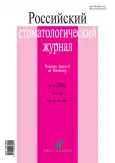Accuracy of the landing of the original and non-original supraconstructions on implants
- Authors: Saveliev V.V.1, Karandin Y.A.1, Kovgan D.S.1
-
Affiliations:
- RUDN University of Russia
- Issue: Vol 26, No 3 (2022)
- Pages: 181-190
- Section: Experimental and Theoretical Investigation
- URL: https://journals.rcsi.science/1728-2802/article/view/106589
- DOI: https://doi.org/10.17816/1728-2802-2022-26-3-181-190
- ID: 106589
Cite item
Abstract
BACKGROUND: An integral part of modern orthopedic dentistry is the rehabilitation of patients with partial or completely missing teeth using intraosseous implant prosthetics. Despite the high success rate of implant integration, practicing dentists continue to encounter biological and technical complications during prosthetic treatment. One of the reasons for the resulting complications is inaccuracies in the design of orthopedic components. Since today the Russian dental market offers a wide range of suprastructures from different manufacturers and price categories, there is a need to compare the accuracy of their designs.
AIM: To identify the difference between the accuracy of fit of original and non-original suprastructures presented in the Russian dental materials market by studying microgaps between these components and original Straumann implants.
MATERIAL AND METHODS: Seven bone-level implants and six tissue-level Straumann implants were used. The original Straumann titanium bone-level and tissue-level bases were used as control superstructures. The following non-original components were used as test specimens: cast cobalt–chromium bone and tissue-level bases from GeoMedi, plastic burnout bone-level abutments from NT-trading, and non-original titanium bone- and tissue-level abutments from GeoMedi, Zirkonzahn, and NT-trading. Cobalt-chromium abutments for tissue-level to a soft state were obtained from GeoMedi. Cobalt–chromium specimens, namely, cast-to-fabricate and pre-smooth abutments from GeoMedi and a plastic burnout abutment from NT-trading, underwent a full technical cycle of metal-ceramic crown fabrication. All specimens were pressed in epoxy using a SimpliMet 1000 automatic hot press. Specimens were ground using a Buehler Beta-1 grinding and polishing machine with an automatic Vector attachment. Grinding was conducted layer by layer in three steps with a step of 1 mm. The contact area was examined with a Tescan Mira LMU scanning electron microscope.
RESULTS: Segments between the implant and abutment and between the abutment and screw were considered in calculating the study results. Using a scanning electron microscope (Tescan Mira LMU), the length of the gap sections not exceeding 1 µm and the length of each gap section exceeding 1 µm were measured on each segment. For each gap, the area percentage was calculated, with the gap width not exceeding 1 µm.
CONCLUSION: For Straumann bone- and tissue-level implants, the original Straumann titanium bases had the highest fit accuracy, but for Straumann bone-level implants, the non-original titanium abutments from GeoMedi and Zirkonzahn also had a similar fit. The fit of the non-original cobalt–chromium bases from GeoMedi and the burnout plastic abutment from NT-trading did not meet the criteria for an accurate fit of the superstructures.
Full Text
##article.viewOnOriginalSite##About the authors
Vasiliy V. Saveliev
RUDN University of Russia
Author for correspondence.
Email: bazilsav@gmail.com
ORCID iD: 0000-0003-0437-1290
MD, Cand. Sci. (Med.); Associate Professor
Russian Federation, MoscowYury A. Karandin
RUDN University of Russia
Email: ykarandin@gmail.com
Russian Federation, Moscow
Dmitry S. Kovgan
RUDN University of Russia
Email: megaspayn@mail.ru
Postgraduate student
Russian Federation, MoscowReferences
- Buser D, Sennerby L, De Bruyn H. Modern implant dentistry based on osseointegration: 50 years of progress, current trends and open questions. Periodontol 2000. 2017;73(1):7–21. doi: 10.1111/prd.12185
- Kano SC, Binon PP, Curtis DA. A classification system to measure the implant-abutment microgap. Int J Oral Maxillofac Implants. 2007;22(6):879–885.
- Yakovlev AT, Badrak EYu, Mikhalchenko DV, et al. A study of microflora at dental implant-abutment interface. Volgograd Journal of Medical Scientific Research. 2015;(1):46–49. (In Russ).
- Mikhalchenko DV, Badrak EYu, Mikhalchenko AV, Yarygina EN. The internal interface of dental implants as a hotbed of chronic infection. Medical News of the North Caucasus. 2015;10(3):307–309. (In Russ). doi: 10.14300/mnnc.2015.10073
- Mikhalchenko DV, Yakovlev AT, Badrak EYu, Mikhalchenko AV. Inflammation in periimplant tissues and factors underlying inflammation (a review). Volgograd Journal of Medical Scientific Research. 2015;(4):15–17. (In Russ).
- Larrucea Verdugo C, Jaramillo Núñez G, Acevedo Avila A, Larrucea San Martín C. Microleakage of the prosthetic abutment/implant interface with internal and external connection: in vitro study. Clin Oral Implants Res. 2014;25(9):1078–1083. doi: 10.1111/clr.12217
- Rismanchian M, Hatami M, Badrian H, et al. Evaluation of microgap size and microbial leakage in the connection area of 4 abutments with Straumann (ITI) implant. J Oral Implantol. 2012;38(6):677–685. doi: 10.1563/AAID-JOI-D-11-00167
- Duraisamy R, Krishnan CS, Ramasubramanian H, et al. Compatibility of nonoriginal abutments with implants: evaluation of microgap at the implant-abutment interface, with original and nonoriginal abutments. Implant Dent. 2019;28(3):289–295. doi: 10.1097/ID.0000000000000885
- Gross M, Abramovich I, Weiss EI. Microleakage at the abutment-implant interface of osseointegrated implants: a comparative study. Int J Oral Maxillofac Implants. 1999;14(1):94–100.
- Ramalho I, Witek L, Coelho PG, et al. Influence of Abutment Fabrication Method on 3D Fit at the Implant-Abutment Connection. Int J Prosthodont. 2020;33(6):641–647. doi: 10.11607/ijp.6574
- Solá-Ruíz MF, Selva-Otaolaurruchi E, Senent-Vicente G, et al. Accuracy combining different brands of implants and abutments. Med Oral Patol Oral Cir Bucal. 2013;18(2):e332–336. doi: 10.4317/medoral.18137
- Linkevicius T. Zero bone loss. Moscow: Dental-Azbuka, 2020. 281 p. (In Russ).
Supplementary files





















